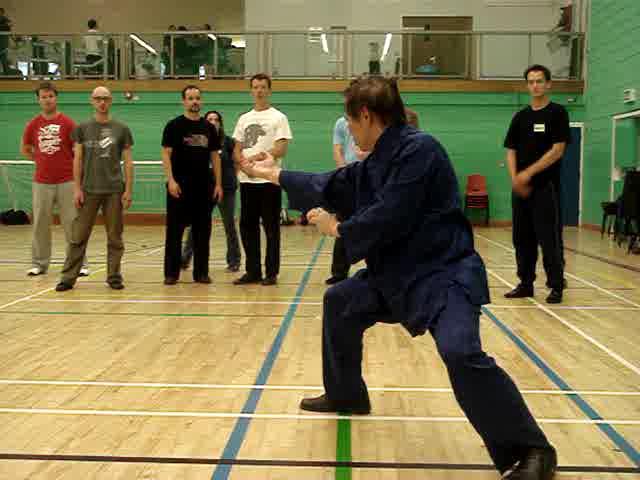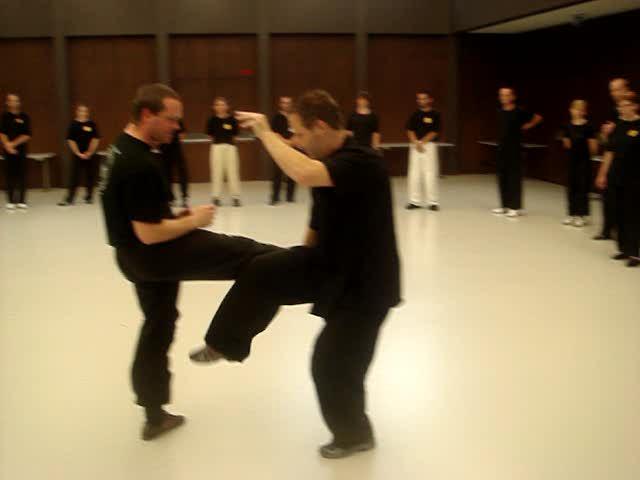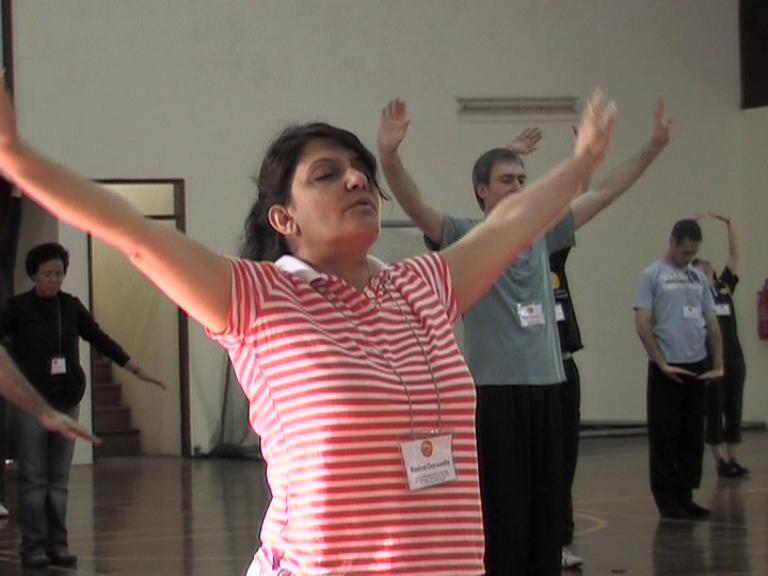SELECTION OF QUESTIONS AND ANSWERS
AUGUST 2011 PART 2

Kungfu that cannot be used for combat is not real kungfu
Question 1
As a big fan of the Southern Shaolin styles it is difficult to find a good Southern style school where I live.
— Csaba, Canada
Answer
Today it is difficult to find good kungfu schools of any styles anywhere in the world. Indeed, it is even difficult to find a school that teaches genuine kungfu.
I am aware that many people may not be happy with the above two statements, and may accuse us of belittling them though we never mean to. We are just stating the fact, but not many people realize this fact.
I repeat the fact: Today it is difficult to find a school that teaches kungfu, i.e. genuine kungfu and not just kungfu forms or Kick-Boxing. Hence, it is even more difficult to find a school teaching good kungfu.
The key word is "kungfu". Many people do not realize it is difficult to find a kungfu school today because they mis-understand the term "kungfu", or interpret it differently.
By "kungfu" I mean the classical Chinese art of attack and defence. (Chinese attack and defence using modern weapons, like guns and bombs, is not classified as kungfu. Practitioners of kungfu may not necessarily be Chinese.) There are many styles of kungfu, such as Shaolin, Taijiuan, Baguazhang, Xingyiquan, Hoong Ka, Wing Choon, Choy-Li-Fatt, Praying Mantis and Eagle Claw.
Hence, by this definition an art that cannot be used for attack and defence is not kungfu. Past kungfu masters called such an art "fa kuen sau thieu" in Cantonese, or "fa quan xiu tui" in Mandarin, and it means "flowery fists and embroidery kicks".
A great majority of people who say and honestly believe they practice kungfu are actually practicing such an art. Their forms are genuine kungfu forms, and they come from genuine lineages of past kungfu masters, but they themselves cannot use their art for attack and defence.
On the other hand, there are people who practice kungfu forms and are good at attack, though they may not be good at defence. They are good at hitting and kicking their sparring partners in free sparring, or their opponents in real fighting, but they themselves will be kicked and hit too. However, they do not use kungfu forms in their sparring and fighting; they usually use Boxing and Kick-Boxing.
This is a modern phenomenon. Hence, past kungfu masters did not have a term for such an art as it did not exist in the past. It would not be approriate to name such an art "flowery fists and embroidery kicks" because its practitioners can cause serious damage in sparring or fighting, though they themselves are also damaged. For convenience, we may call it kungfu-boxing, or kungfu-kickboxing, but not (genuine) kungfu.
Hence, a classical Chinese art that can be used for attack and defence is kungfu, but in our oppinion if it is detrimental to its practitioners' health though the practitioners can be good fighters, it is not good kungfu. Good kungfu must contribute to the practitioners' health, vitality and longevity.
I would repeat that this is our opinion in Shaolin Wahnam, that good kungfu should contribute to health, vitality and longevity. Many martial artists, kungfu as well as non-kungfu practitioners, believe that if they can beat their opponents, theirs is good kungfu or a good martial art. They do not pay attention to health, vitality and longevity.
Above good kungfu is great kungfu. Great kungfu contributes not only to combat efficicency, good health, vitality and longevity, but also to spiritual cultivation. Please note that "spiritual" in not "religious". In other words, in practicing great kungfu a practitioner not only cultivates physically, but also emotionally, mentally and spiritually. For example, he is not only physically healthy and fit, but also emotionally stable, mentally fresh and experiences spiritual joys.
Teachers teaching great kungfu are rare, but if you search you may find them. Indeed, literally thousands of kungfu practitioners not only have wasted a lot of time but also harm themselves in their training because they never knew what genuine kungfu was when they started, and they never searched for teachers who could give them the benefits genuine kungfu would give.
Question 2
I started Hung Gar when I was little. Then it disappeared here in my city. When I search for Hung Gar schools, there are always a lot of issues. like sifus claiming to know 20 to 30 different styles. Other schools only teach for recreation. They don't even know what the meaning behind the forms are. It's just recreation. It's very strange.
Answer
It is not strange, and it applies to all styles of kungfu, not just to Hoong Ka. It is actually the norm today, even in China where kungfu is known as wushu. "Wushu" means martial art, but wushu schools today in China as well as all over the world teach only kungfu forms without understanding the combat meaning behind the forms.
When wushu practitioners spar, they do not use the wushu forms they learn in solo practice; they use kick-boxing. In Chinese, sparring is called "sanda". Sanda, or free sparring, was practiced by kungfu practitioners in the past too.
In the past, kungfu practitioners used the kungfu forms in sanda or free sparring. But today, because kick-boxing is so universally used and kungfu forms never, when "sanda" is mentioned, people have the impression that it is kick-boxing free sparring.

Hoong Ka is a beautiful southern Shaolin style
Question 3
I love Chinese culture and I love Chinese Southern Kung Fu. I'm the opposite of most people and a lot of Chinese who prefer Northern Styles. I've always loved Hung Gar. If Kung Fu is taught it should be real and physical which includes all of the aspects of combat and it should be mental and spiritual as well. If not I can't call it Kung Fu.
Answer
Both northern styles and southern styles are great kungfu. Both too have lost their essence. Most kungfu practitioners today, irrespective of whether they practice northern or southern styles, practice only their external forms, with little or no ability in applying the forms in combat. Most kungfu practitioners today also have no experience of internal force, which is the hallmark of great kungfu.
Hoong Ka is a beautiful Southern style. It was a direct off-shoot from the style of Shaolin Kungfu practiced at the Southern Shaolin Temple when it was burnt by the Ching Army.
I prefer using the spelling "Hoong Ka" to using "Hung Gar". With the funny system of English phonetics, "Hoong Ka" gives a better chance of the name being pronounced correctly, whereas it is easy to mis-pronounce "Hung Gar", with "hung" as in "hungry", and "gar" as in "garden". Here "Hung" should be pronounced as "hoong", with a long "u" sound, and "Gar" like "car" with "c" sounds as "k" and with silent "r'.
You are absolutely right to say that without combat it cannot be called "kungfu". It still can be kungfu if it lacks mental and spiritual aspects, but I would not regard such kungfu as great.
Question 4
As a well travelled and experienced Sifu, in your wisdom what should I do?
Answer
Previously I would advice sincere seekers like you to learn from a good kungfu master, i.e. one who does not merely teach kungfu, but at least teach good kungfu, if not great kungfu. Please see my explanation above regarding kungfu, good kungfu and great kungfu.
However, more often than not these seekers end up learning "flowery fists and embroidery kicks" or kungfu-kickboxing.
So, to save you time and frustration, I would advice you and sincere seekers like you to learn from any one of our certified Shaolin Kungfu instructors. When you have some kungfu basics, attend my Intensive Shaolin Kungfu Course.
The advice sounds like self-advertisement, but it is the most practical I can offer. It is also the most logical. If you want to learn kungfu that you can use for combat as well as gives you good health, vitality, longevity, emotional stabilify, mental freshness and spiritual joys, learn from schools or teachers that teach such type of kungfu. Our school does so.
They are also other schools that do so, but they are rare, and you have to find them. You also need to know how to differentiate these rare schools from many others that claim similar benefits but use kick-boxing for combat and damage your health in their training.

Sifu Roland Mastel demonstrating Praying Mantis Kungfu with a student
Question 5
I loved watching your videos on the Southern Styles. I've always been impressed by the grounded legwork and the footwork involved. There is always footwork for every movement and scenario.
Answer
Thank you for your kind words. Your words remind me of two comments I often heard in my young days.
Kungfu masters commented that one could tell how good a person's kungfu was by observing his "ma-pou" ("mabo" in Mandrin), which means stance and footwork.
On the other hand, many Chinese often commented that one's kungfu was not good because there was no "ma-pou".
Many of our students discovered from direct experience soon after learning from us how important stance and footwork were in combat. Looking back at my own experience, I discovered that the main reason I was undefeated in the many fights I had in my young days was because of my good stance and footwork.
There is a kungfu saying that 30% of victory comes from the hands, and 70% from the legs. For those who bounce about like Boxers, it is diffuclt to appreciate or even understand the validity of this saying.
Question 6
I have overcome the pain at my hip joint by reducing the practise time of repetitions as you told me. I'm very happy for this. And I can't thank you enough!
Since about 10 days I have a spontaneous variation in the performance of "Lifting the Sky" which I interpret as a natural chi flow, during the phase of breathing out and lowering down the arms. At about half the run or before, my arms tend to quickly drop down with emission of a sound similar to a roar which also involves swelling of the cheeks and trembling of the lips. The sensation is that of a beneficial force that strongly crosses my body.
This involves also an acceleration of air emission while I breathe out. I did not intellectualize this effect. And indeed I do not feel to have any negative effect. However today I remember that breathing has to be gentle during "Lifting the Sky". I think this is a case in which chi flow manifests during the performance of the exercise itself, a fact that you spoke about at Finale Ligure. This is to ask you: is it all OK? Am I performing "Lifting the Sky" well?
— Massimo, Italy
Answer
No, this is not OK. You are again heading for trouble, like what you did.
In my previous reply to your questions, I took a lot of time and trouble to explain to you not to over-train and not to worry unnecessarily. This helped you to overcome your hip pain.
Now you are repeating the same mistakes you made, and yet you ask me again whether it is OK!
Forget about all the unnecessary details you worry about while performing "Lifting the Sky" or any other chi kung exercise. Just perform the exercise and enjoy it.

Don't worry, don't intellectualize, just enjoy performing "Lifting the Sky" and you will get a lot of benefits
Question 7
Chi flow also appears while I perform 49 repetitions of many of the Sinew Metamorphosis exercises.
Answer
Why did you perform many of the Sinew Metamorphosis exercises 49 times?
Depending on the level of the class, I tell students to perform a Sinew Metamorphosis exercise 3 times, 6 times or 12 times. 3 times is for advanced level, 6 for intermediate and 12 for beginners.
You perform the exercise 49 times when you have been told to perform it only 12 times at the most. And you ask whether it is alright.
If you are sick, and your doctor asks you to take 12 pills at the most, but you take 49. Is it alright?
I would like to tell you again. Our chi kung is very powerful, even at a beginners' level. If you want to practice high-level chi kung like ours, you just have to follow instructions, otherwise you will hurt yourself even if you perform the techniques correctly. If you cannot follow instructions, or do not want to follow instructions, honestly for your own sake, practice some other much lower level chi kung, or some gentle physical exercise.
Question 8
I would like to integrate my daily training with some gentle stretching for extending leg muscles and, cautiously, opening the hip. Is it a good idea?
Answer
No, it is not a good idea to mix up our chi kung exercises with some other physical exercises.
If you wish to practice leg stretching exercises, do so at a different time.
But more important is your mind set. What you learned at the Shaolin Wahnam chi kung courses at Finale Ligure is very high-level chi kung, that was taught to emperors and generals in the past. If you could attain only a quarter of the standard taught at the courses, you would have done very well. There is no need to try to improve it by changing the instructions given or adding other exercises to it.
Question 9
I would like to restart practising the Three-Circle Stance after a stop of many months.
My actual Chi Kung training lasts about 15 minutes, twice a day. I maintain this currently as my base because I learned it directly from you and is proving to be highly effective for my health. I don't know if the rule of "15 minutes a session/two sessions a day" includes any chi kung type or is to be applied only to generating energy flow exercises. Thus I would try to practise Three-Circle Stance if you tell me that this type of exercise can be added to the practice of generating energy flow.
So to modify anything in my training I would need your statement on this matter. Your answer would be important for me to hold down my wish to do it, and not to make additional mistakes.
Answer
There is no need to add Three-Circle Stance to your present training programme, especially if you learn the stance on your own.
As you are getting a lot of benefits from your present training programme, it would be silly of you trying to change it or add something to it. If you do so, you are likely to make mistakes again like what you did before.
Editorial Note
: Massimo's other questions can be found in the
August 2011 Part 3
issue.
LINKS
Selected Reading
- On God, Buddha and Immortals
- It is a Coomon Mistake to Practice the Iron-Wire Set as an Isometric Exercise
- Channelling Chi
- Mesa Verde of Colorado
- 50 Sequences of Eagle Clas Kungfu
